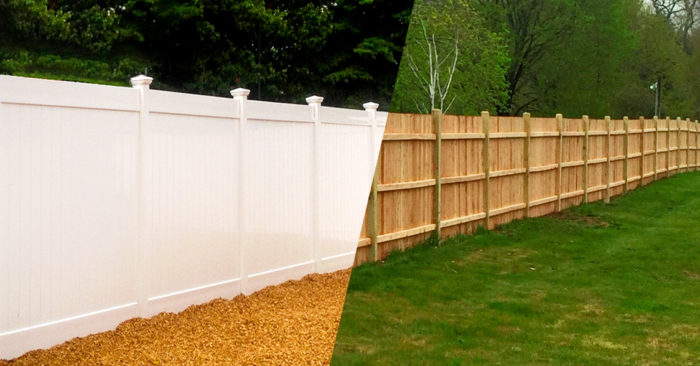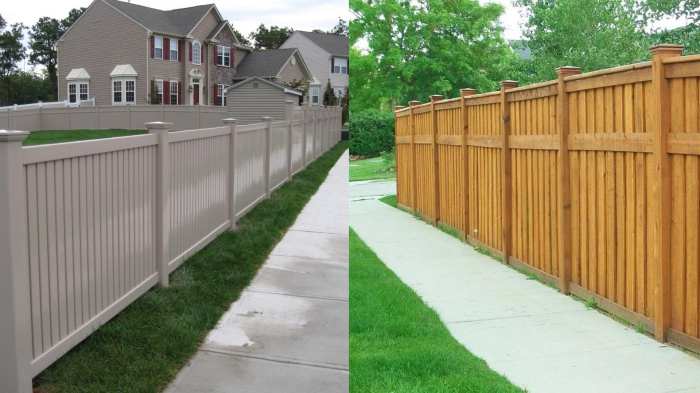Comparing vinyl fencing to wood fencing opens up a world of possibilities for homeowners looking to enhance their properties. This discussion dives into the key differences between these two popular fencing options, shedding light on their features, durability, maintenance needs, and installation processes.
Let's explore the pros and cons of vinyl and wood fencing to help you make an informed decision for your home.
Vinyl Fencing
Vinyl fencing is a popular choice for homeowners looking for a low-maintenance and durable fencing option. Made from PVC (polyvinyl chloride), vinyl fencing offers a variety of benefits compared to traditional wood fencing.
Key Features of Vinyl Fencing
- Vinyl fencing is highly durable and can withstand harsh weather conditions, such as extreme heat, cold, and moisture, without warping, cracking, or rotting.
- It is available in a wide range of styles, colors, and textures, allowing homeowners to customize their fencing to fit their aesthetic preferences.
- Vinyl fencing is easy to clean and maintain, requiring only occasional washing with soap and water to keep it looking new.
- Unlike wood fencing, vinyl fencing does not need to be repainted or stained, saving homeowners time and money on maintenance costs.
Durability of Vinyl Fencing
Vinyl fencing is known for its exceptional durability, outlasting wood fencing in harsh weather conditions. The PVC material used in vinyl fencing is resistant to rot, decay, and insect damage, ensuring that your fence will remain in top condition for years to come.
Maintenance Required for Vinyl Fencing
Vinyl fencing requires minimal maintenance compared to wood fencing. Regular cleaning with soap and water is usually sufficient to keep vinyl fencing looking new. Additionally, vinyl fencing does not need to be repainted or stained, eliminating the need for ongoing maintenance tasks.
Cost of Installation
When it comes to the cost of installation, vinyl fencing is generally more expensive upfront compared to wood fencing. However, due to its low maintenance requirements and long lifespan, vinyl fencing can be a cost-effective option in the long run, as it eliminates the need for frequent repairs and treatments associated with wood fencing.
Wood Fencing
Wood fencing holds a traditional charm that many homeowners find appealing. The natural look of wood blends well with various architectural styles, adding a warm and inviting feel to any property.
Environmental Impact
Wood fencing has a significant environmental impact due to the sourcing of timber. Deforestation and habitat destruction can result from the demand for wood fencing materials. However, opting for sustainably sourced wood or reclaimed wood can help mitigate these negative effects.
Maintenance Needs
Wood fencing requires regular maintenance to keep it looking its best. This includes staining or painting to protect the wood from rot, warping, and insect damage. Additionally, annual inspections are necessary to identify and address any issues promptly.
Lifespan
The lifespan of wood fencing can vary depending on the type of wood used and the level of maintenance performed. On average, untreated wood fencing can last around 5 to 12 years, while treated wood can extend the lifespan to 20 years or more with proper care.
Aesthetics

Vinyl fencing and wood fencing offer distinct aesthetic qualities that can greatly impact the overall look of a property. Let's explore the differences in their visual appeal and how they can complement various architectural styles.
Vinyl Fencing Styles and Designs
Vinyl fencing comes in a wide range of styles and designs, offering versatility and customization options for homeowners. Some popular styles include privacy fences, picket fences, and decorative fences. Vinyl fences can mimic the look of traditional wood fences or offer a more modern and sleek appearance.
With a variety of colors and textures available, vinyl fencing can easily match the aesthetic of any property.
Wood Fencing Natural Look
Wood fencing is known for its classic and natural look, adding warmth and charm to any property. The organic beauty of wood can enhance the overall landscape and create a rustic or traditional feel. Depending on the type of wood used, wood fences can range from a light, airy appearance to a rich, dark finish.
The natural aging process of wood can also add character and uniqueness to the fence over time.
Complementing Architectural Styles
Both vinyl and wood fencing can complement different architectural styles, enhancing the curb appeal of a property. For example, a white vinyl picket fence can enhance the charm of a cottage-style home, while a dark-stained wood fence can complement a craftsman or rustic-style house.
The key is to choose a fence style and material that harmonizes with the overall design of the property, creating a cohesive and visually appealing look.
Installation and DIY
When it comes to installing fencing, whether vinyl or wood, the process can be quite involved. Each material has its own set of requirements and considerations that need to be taken into account.
Vinyl Fencing Installation
Installing vinyl fencing typically requires fewer tools and less skill compared to wood fencing. The process usually involves assembling pre-made panels and securing them to the posts. Here are some tools and skills required for a DIY vinyl fencing installation:
- Tools: level, measuring tape, post hole digger, screws, and a drill.
- Skills: basic knowledge of using tools, measuring accurately, and following instructions.
Complexities of Wood Fencing Installation
Wood fencing installation can be more complex than vinyl fencing due to the nature of the material. Wood may require more precise cutting, leveling, and securing, which can be challenging for beginners. Here are some tips for maintaining a straight and sturdy fence during installation:
- Use a level to ensure posts are straight and at the right height.
- Secure posts with concrete to prevent shifting over time.
- Measure twice and cut once to avoid mistakes in sizing.
- Regularly check the alignment of panels to maintain a straight fence.
Last Recap

In conclusion, the choice between vinyl fencing and wood fencing ultimately depends on your preferences, budget, and long-term goals for your property. By weighing the factors discussed in this comparison, you can select the fencing option that best suits your needs and complements the aesthetic of your home.
Whether you opt for the sleek modern look of vinyl or the timeless appeal of wood, both choices offer unique benefits that can enhance the beauty and functionality of your outdoor space.
Questions Often Asked
Is vinyl fencing more durable than wood fencing?
Yes, vinyl fencing is known for its durability and resistance to elements like rot and insects, making it a longer-lasting option compared to wood fencing.
What is the typical lifespan of wood fencing?
Wood fencing can last around 20-30 years with proper maintenance, but it may require more upkeep compared to vinyl fencing.
Are there any eco-friendly aspects to vinyl fencing?
Vinyl fencing is not biodegradable like wood, but it can be recycled, making it a more sustainable choice in the long run.














